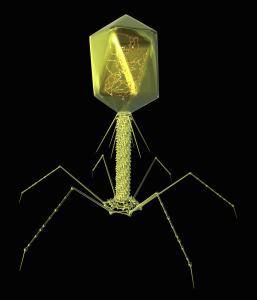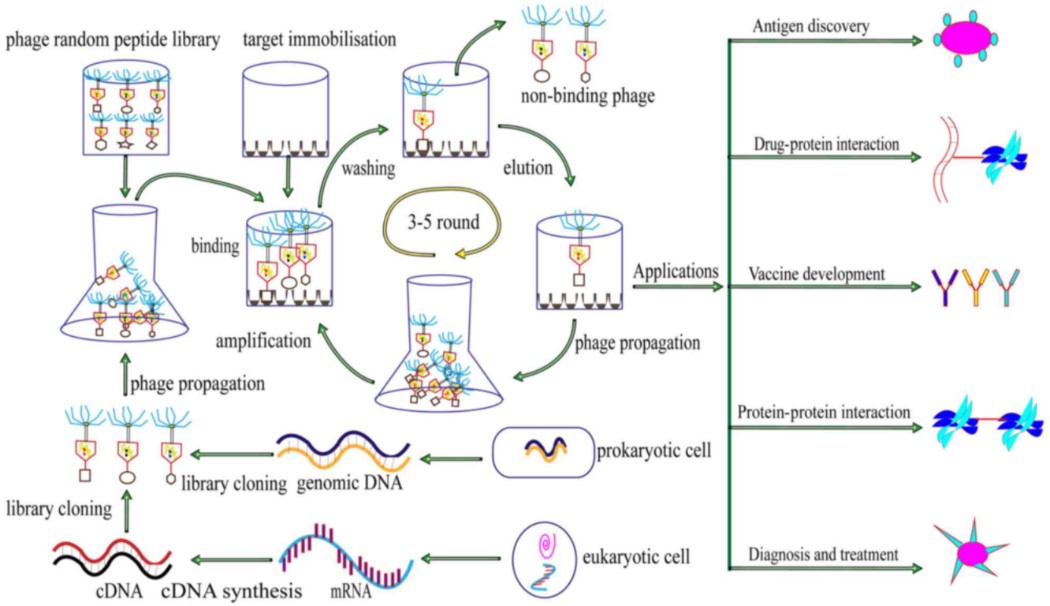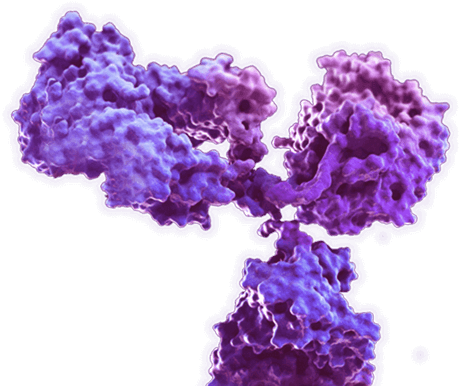Bacteriophage Antibody
Supported by in-house scientists and first-in-class technical platform, Creative Biolabs is confident in providing a series of high-quality Bacteriophages antibody products and services to assist biologists in genetics and molecular biology research.
Background

Bacteriophages, a ubiquitous feature of prokaryotes, are the most abundant organisms in the biosphere.
Phage was discovered 100 years ago and has been a key tool in biological research ever since. Bacteriophages were originally used as model organism in genetics and molecular biology and are now considered to be one of the main drivers of bacterial evolution and diversification. The introduction of sequencing technology, phage genomics and metagenomics has highlighted their tremendous diversity and role in controlling ecosystems in various environments. Due to their specificity, phage genomes are now also used as therapeutic agents, potentially providing an alternative to conventional antibiotics.
Research area of Bacteriophage as model organism
- Bacteriophage is considered to be useful in many fundamental biological concept formations.
- Bacteriophages play an important role in vaccine research.
- T4 bacteriophage display technology is an important molecular tool with a key impact on drug discovery, immunology, pharmacology, and plant science.
- Using bacteriophages as an alternative method is proposed to control pathogenic bacteria.
These include clear identification of nucleic acids as the genetic material; Definition of the natural genetic code of the gene demonstration triad through fine structure of recombination, mutation, and functional analysis; mRNA discovery; the significance of recombination in DNA replication; prokaryote’s self-splicing introns and many others. As T4 phages completely inhibit host gene expression, allowing researchers to distinguish between phage and host macromolecule synthesis, is an excellent model system.
T4 bacteriophages are used to deliver vaccines or as delivery vehicles for DNA vaccines or as a form in which immunogenic peptides are attached to the modified coat proteins of T4 bacteriophage. Display of T4 bacteriophage helps to identify immunogenic antigens or epitopes on displayed peptides, laying the foundation for the development of peptide vaccines.
 Fig.1 The principle, process and application of phage display technology.
Fig.1 The principle, process and application of phage display technology.
Display technology is a technique for the presence of foreign proteins, peptides, or antibody fragments on the surface of T4 bacteriophage particles. The heterologous protein or peptide is cloned into phagemid genome or a T4 bacteriophage by transcriptional fusion. Thus, T4 bacteriophages become expression vehicles along with the nucleotide sequence in the protein they encode, allowing the gene sequence to be retrieved and also have the ability to replicate.
Many studies have shown successful use of bacteriophages in different fields such as food safety, agriculture, aquaculture, and even human health. Several companies are commercializing bacteriophages or bacteriophage-based therapeutic products. In the 1940s The Eli Lilly Company developed T4 bacteriophage products against Escherichia coli for human use.
Scientists at Creative Biolabs are dedicated to bringing together years of valuable experience to help our clients shorten the research journey. We are committed to the Bacteriophages antibody products and services and dedicated to reducing the overall project development timeline for our clients.
Our provided hot target antibody products include the followings, but not limited to:
Target Selection
Reference
- Deng X Y, Wang L, You X L, et al. Advances in the T7 phage display system (Review). Mol Med Rep. 2018, 1;17(1):714-720.
AibGenesis™ Mouse Anti-Bacteriophage M13 Antibody (MO-AB-70564W) (CAT#: MO-AB-70564W)
-
- Host species: Mouse
- Species Reactivity: M13 Bacteriophage
- Application: WB, ELISA, FC, IHC
- Size: 200µg
- Conjugate: NONE
AibGenesis™ Mouse Anti-Bacteriophage ms2 coat protein (Full length, clone ms2109-071) Antibody (Cat MO-DKB-03898W) (CAT#: MO-DKB-03898W)
-
- Host species: Mouse
- Species Reactivity: Bacteriophage
- Application: WB
- Protein: Coat protein
- Size: 40µL
- Conjugate: Unconjugated
- Alternative Names: Bacteriophage ms2 coat protein
Goat Anti-Bacteriophage Cre protein Antibody (Cat MO-DKB-03946W) (CAT#: MO-DKB-03946W)
-
- Host species: Goat
- Species Reactivity: BacteriophageP1
- Application: WB
- Size: 0.15mg, 0.3mg, 1.5mg
- Conjugate: Unconjugated
- Alternative Names: Bacteriophage Cre protein
AibGenesis™ Mouse Anti-M13 g8p coat protein Antibody (Cat MO-DKB-03892W) (CAT#: MO-DKB-03892W)
-
- Host species: Mouse
- Species Reactivity: Virus, M13 Bacteriophage
- Application: ELISA, FC
- Size: 100µg
- Conjugate: Unconjugated
- Alternative Names: M13 Bacteriophage coat phage protein pVIII, M13 pVIII protein, M13 pVIII coat protein, M13 antibody (g8p), M13 Bacteriophage coat phage protein pVIII, M13 pVIII protein, M13 pVIII coat protein, M13 (g8p)
AibGenesis™ Mouse Anti-M13 g8p protein Antibody (Cat MO-DKB-03894W) (CAT#: MO-DKB-03894W)
-
- Host species: Mouse
- Species Reactivity: M13 Bacteriophage
- Application: ELISA
- Size: 100µg
- Conjugate: Unconjugated
- Alternative Names: M13 g8p protein, M13 Bacteriophage
AibGenesis™ Mouse Anti-M13 protein Antibody (Cat MO-DKB-03897W) (CAT#: MO-DKB-03897W)
-
- Host species: Mouse
- Species Reactivity: M13 Bacteriophage
- Application: ELISA, FC, IHC-Fr
- Size: 0.25mg
- Conjugate: Unconjugated
- Alternative Names: M13 protein, M13 Bacteriophage
Rabbit Anti-uvsY (AA 1-137) Antibody (Cat MO-DKB-03949W) (CAT#: MO-DKB-03949W)
-
- Host species: Rabbit
- Species Reactivity: Enterobacteria phage T4
- Application: ELISA
- Protein: Recombination protein uvsY
- Size: 100µg, 50µg
- Conjugate: Biotin, FITC, HRP, Unconjugated
- Alternative Names: Recombination protein uvsY, uvsY
Rabbit Anti-2.5 protein (AA 1-232) Antibody (Cat MO-DKB-03950W) (CAT#: MO-DKB-03950W)
-
- Host species: Rabbit
- Species Reactivity: Enterobacteria phage T7
- Application: ELISA
- Protein: Single-stranded DNA-binding protein
- Size: 100µg, 50µg
- Conjugate: Biotin, FITC, HRP, Unconjugated
- Alternative Names: SSB protein, gp2.5, SSB protein, 2.5
Rabbit Anti-stxB2 (AA 20-89) Antibody (Cat MO-DKB-03960W) (CAT#: MO-DKB-03960W)
-
- Host species: Rabbit
- Species Reactivity: Enterobacteria phage 933W
- Application: ELISA
- Protein: Shiga-like toxin 2 subunit B
- Size: 100µg, 50µg
- Conjugate: Biotin, FITC, HRP, Unconjugated
- Alternative Names: SLT-2 B subunit, SLT-2b, SLT-IIb, Verocytotoxin 2 subunit B, Verotoxin 2 subunit B, L0104, stx2B, stxB2, SLT-2 B subunit, SLT-2b, SLT-IIb, Verocytotoxin 2 subunit B, Verotoxin 2 subunit B, L0104, stx2B, stxB2
Rabbit Anti-III Protein (AA 19-424) Antibody (Cat MO-DKB-03961W) (CAT#: MO-DKB-03961W)
-
- Host species: Rabbit
- Species Reactivity: Enterobacteria phage M13
- Application: ELISA
- Protein: Attachment protein G3P
- Size: 100µg, 50µg
- Conjugate: Biotin, FITC, HRP, Unconjugated
- Alternative Names: Attachment protein G3P, Gene 3 protein, G3P, Minor coat protein, III, Attachment protein G3P, Gene 3 protein, G3P, Minor coat protein, III
Rabbit Anti-stxB (AA 21-89) Antibody (Cat MO-DKB-03962W) (CAT#: MO-DKB-03962W)
-
- Host species: Rabbit
- Species Reactivity: Enterobacteria phage H19B
- Application: ELISA
- Protein: Shiga-like toxin 1 subunit B
- Size: 100µg, 50µg
- Conjugate: Biotin, FITC, HRP, Unconjugated
- Alternative Names: SLT-1 B subunit, SLT-1b, SLT-Ib, Verocytotoxin 1 subunit B, Verotoxin 1 subunit B, sltB, stxB, SLT-1 B subunit, SLT-1b, SLT-Ib, Verocytotoxin 1 subunit B, Verotoxin 1 subunit B, sltB, stxB
AibGenesis™ Mouse Anti-EBFP Antibody (Cat MO-MMB-0001) (CAT#: MO-MMB-0001)
-
- Host species: Mouse
- Species Reactivity: All
- Application: WB
- Size: 100µL, 200µL, 50µL
- Conjugate: None
- Alternative Names: EBFP
Rabbit Anti-Acetylated Lysine Antibody (Cat MO-MMB-0058) (CAT#: MO-MMB-0058)
-
- Host species: Rabbit
- Species Reactivity: Human, All
- Application: WB, ELISA
- Size: 100µL, 200µL, 50µL
- Conjugate: None
- Alternative Names: Acetylated Lysine
AibGenesis™ Mouse Anti-M13 phage coat protein g8p Antibody (MOFY-0522-FY178) (CAT#: MOFY-0522-FY178)
-
- Host species: Mouse
- Species Reactivity: M13 phage
- Application: FC, IHC, WB
- Protein: M13 phage coat protein g8p
- Size:
- Conjugate:
- Alternative Names: M13 phage coat protein g8p
AibGenesis™ Mouse Anti-M13 bacteriophage g3p Antibody (MOFY-0522-FY179) (CAT#: MOFY-0522-FY179)
-
- Host species: Mouse
- Species Reactivity: M13 phage
- Application: ELISA, FC, IHC, WB
- Protein: M13 bacteriophage g3p
- Size:
- Conjugate:
- Alternative Names: M13 bacteriophage g3p
To download a Certificate of Analysis, please enter a lot number in the search box below. Note: Certificate of Analysis not available for kit components.
Lot Number

